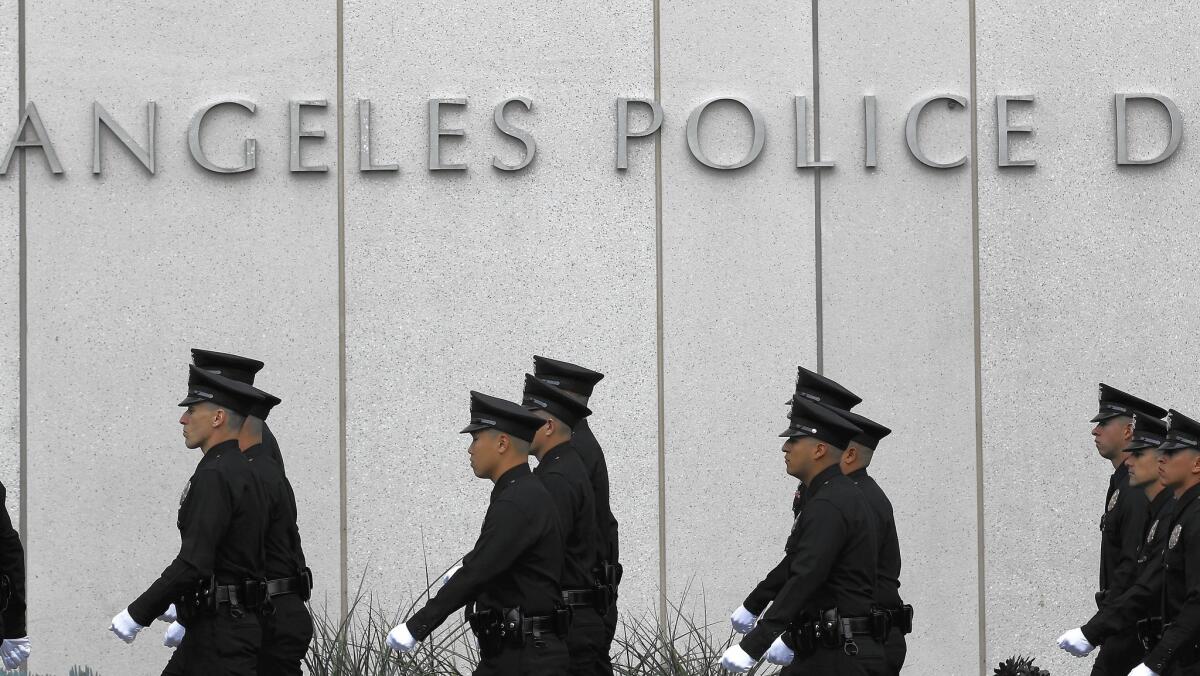LAPD data show few officers report excessive force by peers; better tracking promised

With a new state law requiring police officers to report excessive force by their peers, a Los Angeles police commissioner this summer asked department commanders how many times such reporting had occurred in the last five years.
The answer that Dale Bonner got back, in a July email obtained by The Times through a public records request, was five. When The Times asked for a synopsis of the five incidents, LAPD officials said that the number was actually two.
Amid thousands of unauthorized force complaints from the public since 2015, there were only two documented instances in which an officer had filed an unauthorized force complaint against another officer, they said. Both were in 2016.
In one, an officer reported seeing another yank a handcuffed detainee backward off a bench onto the floor, leading to the offending officer receiving a 10-day suspension and demotion. In the other, an officer reported being in a vehicle with two supervisors when one activated a personal stun gun and the other pulled out a handgun. The first supervisor received a 12-day suspension, the second a 22-day suspension.
From 2017 to 2019, the Los Angeles Police Department fielded more than 2,200 unauthorized force complaints against officers. Not a single one was recorded as having been filed by a fellow officer, according to department records.
There also have not been any recorded cases of officers filing excessive force complaints so far this year, despite members of the public filing more than 50 such complaints over their treatment by officers at massive protests in the city this summer.
Both LAPD Chief Michel Moore and Deputy Chief Robert Marino, who heads the LAPD’s professional standards bureau, told The Times the low number of recorded complaints is misleading — based on inadequate tracking of such reporting, more than anything else.
“We’re not capturing it right, the data,” Marino said.
Marino said there were probably other undocumented instances in which officers quietly reported excessive force to a supervisor, but the supervisor never mentioned the origins of the complaint when pursuing it. Moore said in cases in which excessive force is obvious and immediately documented, officers routinely provide fair and truthful assessments of their partners’ actions.
In fact, Moore said officers are routinely punished for not reporting such force by their peers in cases in which the misconduct comes to light in some other way, which he knows because he personally oversees the discipline process. However, neither he nor Marino could provide data on such punishments.
“We continue to refine our systems to better analyze for a number of variables to better understand the interplay of factors,” Moore told The Times, referring to the shortcomings in the data.
Marino said he was working on a system to better track such incidents moving forward, including putting a “check box” on forms in which alleged excessive force is detailed so that those filling out the paperwork can indicate whether the complaint originated with another officer.
“We’re trying to create a program within internal affairs that captures that,” Marino said.
The move follows a national push by reform activists and lawmakers to hold police more accountable for their treatment of people on the street, including by requiring officers to report their peers when they witness abuse.
Late last year, lawmakers in Sacramento passed a law requiring that all California police agencies adopt policies mandating peer reporting of excessive force by January 2021. LAPD commanders said such reporting wasn’t new for them — that the LAPD has long required it — but the Police Commission nonetheless revised the use-of-force policy.
Bonner, who received the raw data from Moore in a July 21 email, said he had not followed up with police since then, but intended to do so. He said that the number of recorded instances of peer reporting did seem low, but that he was reluctant to reach any conclusions when so much remains unknown about what is occurring and how officers with concerns are communicating them.
“I’m certainly not throwing my hands up and saying, ‘Well, this is the way it is.’ What I’m also not doing is going the other way and conjecturing,” Bonner said in an interview. “My interest also is not just in improving the form and improving the policy and paper on it, but trying to understand how it really plays out in real time.”
Properly understanding what is occurring will require conversations with officers “who are actually on patrol and responding to incidents,” he said.
Dustin DeRollo, a spokesman for the Los Angeles Police Protective League, said the union supports peer reporting and believes it occurs routinely as officers report incidents to their supervisors and comply with internal investigations.
Activists and lawmakers welcomed commitments to improve tracking, saying accountability won’t come without it.
“No matter what the policy is, if you don’t have an accountability structure to enforce it, it’s just words on a paper,” said Sam Sinyangwe, an activist with the organization Campaign Zero, which has advocated for peer-reporting policies nationwide.
State Sen. Anna Caballero (D-Salinas), who sponsored the bill that mandated such reporting, said that police agencies have until January to comply with the law, and that if they do so without establishing clear tracking protocols, new legislation may be in order.
Reducing the use of force has been a key goal of the LAPD for years, and the department has had some success. LAPD shootings are way below where they once were, hitting a 30-year low last year.
However, overall complaints last year were up. According to LAPD data, a total of 3,763 complaints were fielded in 2019 for an array of alleged offenses, most of which were filed by members of the public. There were 3,567 complaints in 2018 and 3,217 in 2017.
Few complaints result in punishment for officers. Of the 2,200 unauthorized force complaints between 2017 and 2019, only 70 were sustained by the department. None was recorded as having been filed by a fellow officer.
Asked why LAPD officers, who always work with partners, don’t report possible excessive force more often given the thousands of outside complaints, Moore noted that the vast majority of those complaints — more than 95% — were dismissed, some for a lack of evidence but many after being deemed “demonstrably false.”
“The existence of an allegation does not prove there is any substance to it,” Moore said.
Moore also said he didn’t know of a single excessive force investigation in which the officers involved didn’t submit to interviews and share what they knew.
Of course, cooperation in an ongoing administrative investigation is different from proactively reporting an incident the department is unaware of, reform advocates said, and some excessive force would never come to light without peer reporting.
In part because of that, the duty of officers to report and intervene when excessive force occurs has been a focus of reform activists for years, and was one of eight use-of-force policy reforms urged as part of a national reform effort by Sinyangwe’s group called #EightCantWait — which captured the attention of lawmakers nationwide.
DeRay Mckesson, who works with Sinyangwe at Campaign Zero, said the duty to report and intervene is an accountability measure like any other, in that compliance must be tracked for it to be effective.
“The data allows us a different entry point to identify problems and hold the institution accountable,” he said.
Sinyangwe said recent cases of police brutality — including the death of George Floyd after a Minneapolis officer kneeled on his neck as other officers stood by — show that intervention and reporting requirements are necessary tools that will mean little if they aren’t enforced.
“The policy is an important first step in making it possible to hold officers accountable for these things,” he said. “But what is clear is that is not sufficient.”
Caballero said tracking compliance moving forward will be “critical for law enforcement agencies to have a clear picture of how frequent excessive force is used,” and would “ultimately help shape the agency’s response to ensure these situations, which often result in the loss of life, are eliminated.”
She said additional legislation “may be necessary to strengthen the reporting requirements,” but noted that the law gives agencies until January to implement the requirements — giving them “additional time to further develop, implement and refine use of force policies.”
More to Read
Sign up for Essential California
The most important California stories and recommendations in your inbox every morning.
You may occasionally receive promotional content from the Los Angeles Times.











